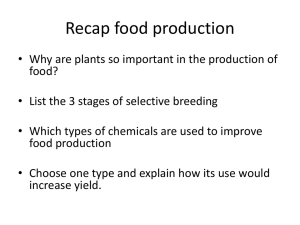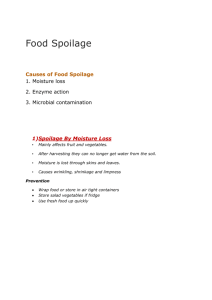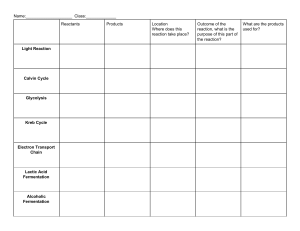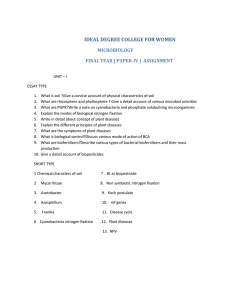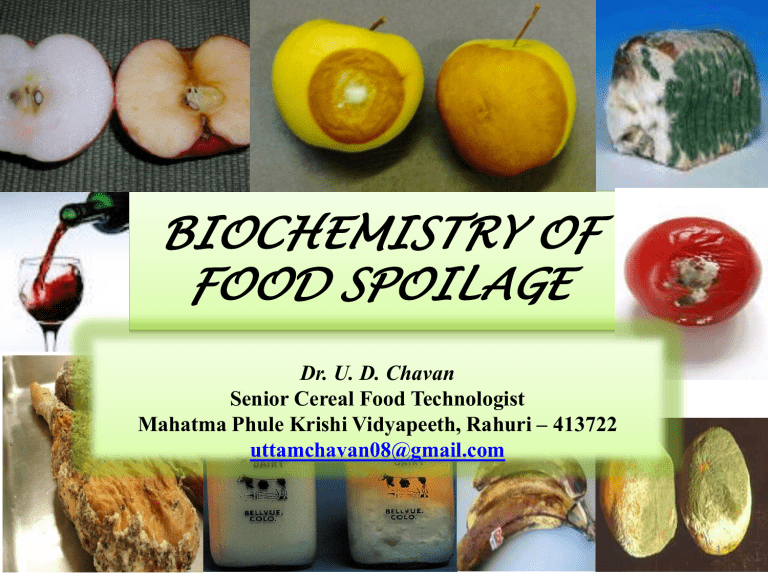
BIOCHEMISTRY OF FOOD SPOILAGE Dr. U. D. Chavan Senior Cereal Food Technologist Mahatma Phule Krishi Vidyapeeth, Rahuri – 413722 uttamchavan08@gmail.com 1 Proteins Carbohydrate Food Energy Vitamins Building materials Human Growth Lipids 2 FOOD GROUPS • Highly Perishable – – – – – Meat Fruit Milk Vegetables Eggs • Semi perishable – Potatoes – Nuts – Flour • Stable – Rice – Dry beans 3 4 Food Food deterioration Food spoilage Economic loss 5 Biochemistry of food spoilage Substrates Chemical reactions Chemical compounds Factors 6 Major causes of food spoilage Physical • • • • Temperature R.H. Light Mechanical damage Chemical • • • • Enzymatic reaction Non enzymatic reactions Rancidity Chemical interaction Microorganisms Others • Bacteria • Yeast • Molds • • • • Insects Rodents Animals Birds 7 LIGHT Oxidation of food Reversion flavor of soyabean Sunlight flavor in milk Rapid loss of Riboflavin, vitamin D, E and C Greening of potato 8 Formation of excited triplet sensitizer (3Sen*) and its reaction with substrate via Type I and Type II reactions Sensitizer 9 (Sharman et al., 2000) Reversion flavor in soybean oil 10 Linolenic acid Linoleic acid 2-pentyl furan 11 2-pentenyl furan (Min, 2000) Effect of chlorophyll on pentenyl furan peak areas Light Exposure(d) Added Chlorophyll 0 ppm 1 ppm 5 ppm 1 0 0 0 2 0 0 0 3 0 0 1502 4 0 1534 3018 12 (Callison, 2001) Riboflavin Photosensitized Singlet Oxygen Oxidation of Vitamin D Vitamin D vitamin D-5,6 epoxide (King, 1996) 13 Head space oxygen of vitamin D2 samples with 15 ppm riboflavin stored in the dark from 1-8 hours 14 (King and Min, 1998) Effect of vitamin D2 and riboflavin concentrations on % headspace oxygen loss during storage in the light from 1 to 8 hours 15 (King and Min, 1998) Singlet Oxygen and Ascorbic Acid Effects on Dimethyl Disulfide and Off-Flavor in Skim Milk Exposed to Light Methionine Dimethyl Disulfide Postulated mechanism of dimethyl disulfide formation by singlet oxygen oxidation of 16 methionine. (Jung et al., 1998) Effects of time of exposure to fluorescent light on headspace volatile compounds and dimethyl disulfide of skim milk A - 2-butanone B - ethanol C - diacetyl D - dimethyl disulfide E - n-butanol 17 (Jung et al., 1998) Effects of ascorbic acid concentration on dimethyl disulfide (peak D) content in skim milk during light exposure for 1h. Ascorbic acid (ppm) 0 200 500 1000 Dimethyl Disulphide (peak D) 13269 6158 4907 4742 (Jung et al., 1998 )18 Greening of potato Light Biosynthesis of chlorophyll Fixation of carbon dioxide Acetate Mevolenic acid Cholesterol 19 + Arginine 20 (Kent et al., 2005) Chlorophyll and solanine synthesis in potatoes Solanine Chlorophyll Light 23⁰C Dark 21 (Ramaswamay et al., 1976) Enzymes that cause food spoilage Enzymes Food Spoilage action Ascorbic acid oxidase Vegetables Destruction of vitamin C Lipase Lipoxygenase Pectic enzymes Milk, oils Vegetables Fruits Hydrolytic rancidity Destruction of vitamin A Destruction of pectic substances (Softening) Fruits Fruits, vegetables Browning Browning, off flavour, vitamin loss Proteases Eggs crab, lobster Flour Reduction of shelf life Overtenderization Reduction in gluten network formation Thiaminase Meats, fish Destruction of thiamine Peroxidases Polyphenoloxidase 22 ENZYMATIC BROWNING Polyphenol oxidase Hydroxylation of monophenol to o-diphenol Phenolic substrate O2 Polyphenol O2 Phenolic oxidase O2 substrate O2 O2 O2 O2 Dehydrogenation of o- diphenol to o-quinone 23 Oxidation of tyrosine by Phenolase and the formation of melanin pigment 24 Post-mortem changes in fish muscle due to autolytic degradation Autolysis 25 (Green, 2011) An overview of fruit ripening with particular emphasis on textural softening Protopectin → Soluble Pectin Decomposition → Softening (over matured fruit) 26 RANCIDITY Oxidative Rancidity Hydrolytic Rancidity Hydrolytic Rancidity Triacylglycerol Glycerol Free fatty acids (Volatile bad odor) 27 Oxidative Rancidity 28 (Baysal and Demirdoven, 2006) MAILLARD REACTION D-glucose Schiff Base Glucosamine 29 Melanoidins (Brown nitrogenous polymer) 30 Microbial Spoilage 31 BACTERIA Microbial Spoilage YEAST MOLDS 32 General pattern of microbial spoilage (Dalgaard, 1993) 33 Factors affecting growth of microbes Intrinsic Nutrients aw pH Redox potential Inhibitors Extrinsic Temperature Humidity Atmosphere Implicit Interactions of microorganisms 34 Fungal spoilage of starch-based foods in relation to its water activity (Abdullah et al., 2000) 35 MICROBIAL SPOILAGE – HOW DOES IT MANIFEST ITSELF? Visible growth Gas production Slime Enzymes Off-flavours 36 Food Types of Spoilage Putrefaction Clostridium, Pseudomonas, Proteus, Alcaligenes, Chromobacterium Souring Chromobacterium, Lactobacillus, Pseudomonas Mouldy Penicillium, Aspergillus, Rhizopus Souring Pseudomonas, Micrococcus, Bacillus Slimy Leuconostoc Souring Greening Lactobacillus, Carnobacterium, Leuconostoc Fresh MEAT Cured Vacuum Packed Poultry Spoilage Microorganisms Odor, Slime Pseudomonas, Alcaligenes, Xanthomonas 37 Food MILK DAIRY CHEESE Fish Eggs Types of Spoilage Spoilage Microorganisms Bitterness Pseudomonas spp. Souring Lactobacillus thermophilus Sweet curdling Bacillus cereus Green discoloration Penicillium Green to black discoloration Cladosporium Black discoloration Candida Sliminess (high pH) Pseudomonas spp. “Gassy” cheese Coliforms, LAB, Clostridia Discoloration Pseudomonas Putrefaction Chromobacterium, Halobacterium, Micrococcus Green rot Pseudomonas Colorless rot Pseudomonas, Alcaligenes, Chromobacterium Black rot Coliforms Fungal rot Proteus, Penicillium, Mucor 38 Food FRESH FRUITS AND VEGETABLES Canned food Wine Types of Spoilage Spoilage Microorganisms Bacterial soft rot Erwinia carotovera, Pseudomonas spp. Gray mould rot Botryitis cinerea Rhizopus soft rot Rhizopus nigrican Blue mould rot Penicillium italicum Black mould rot Aspergillus niger, Alternaria Sliminess and Souring Saprophytic bacteria Flat Sour Bacillus coagulans, B. sterothermophilus Thermophillic acid Clostridium thermosacchrolyticum Sulphide stinker Clostridium nigrificans Butyric acid fermentation C. butyricum Softening of fruits Byssochlamys fulva Sliminess Yeast and molds Off Flavor, bitterness Acetobactor, Oenococcus 39 Chemical changes caused by micro organisms Degradation of carbohydrates Degradation of N- compounds Degradation of lipids Pectin hydrolysis 40 Degradation of carbohydrates Fermentation type Products Alcoholic Fermentation Ethanol, CO2 Homofermentative lactic acid Fermentation Lactic acid Heterofermentative lactic acid Fermentation Lactic acid, Acetic acid, Ethanol, CO2 Propionic acid Fermentation Propionic acid, Acetic acid, CO2 Butyric acid Fermentation Butyric acid, Acetic acid, CO2, H2 Mixed acid Fermentation Lactic acid, Acetic acid, CO2, H2, Ethanol 2,3-butanediol Fermentation CO2, Ethanol, 2,3-butanediol , Formic acid 41 42 Anaerobic Conversion of Lactic Acid to Acetic Acid and 1,2 Propanediol by Lactobacillus buchneri 43 (Stefanie et al., 2001) Lactic acid utilization by Lactobacillus buchneri, a potential spoilage organism in fermented cucumbers (Johanningsmeier , 2011) 44 Lactate utilization in time by L. buchneri at different pH 45 (Stefanie et. al., 2001) Degradation of N- compounds Proteolysis Proteinases Proteins Peptidases Polypeptides Amino Acids Putrefaction Amino Acids Cysteine Methionine Tryptophan Lysine Arginine Histidine Bacterial Cell Cysteine desulfhydrase Methionine lyase Tryptophanase Decarboxylase Volatile products H2S Methyl mercaptans Indole Cadaverine Putrescine Histamine 46 Reduction of trimethylamine oxide trimethylamine oxide trimethylamine Fishy odor Pseudomonas Shewanella Bacillus Clostridium 47 Degradation of lipids lipase Lipids Glycerol + Fatty acid Lipid oxdase Aldehyde , ketones Pseudomonas Micrococcus Staphylococcus Flavobacterium 48 Pectin Degradation Polygalacturonic acid + Methanol Pectin Galacturonic acid Apple rot Penicillium expansum Monilinia fructigena Soft and watery Dry and firm 49 EPS Slime production 50 Viscosity of medium during growth of Pediococcus damnosus 2.6 (◊) and Lactobacillus brevis G-77 (□) at 28°C for 24 h. (Martenssona et al., 2003) 51 Ropiness of medium during growth of Pediococcus damnosus 2.6 (◊) and Lactobacillus brevis G-77 (□) at 28°C for 24 h (Martenssona et al., 2003) 52 Rope-Producing Strains of Bacillus spp. from Wheat Bread Total numbers of rope-spoiled breads during storage at 23 and 30°C 53 (Pepe, et. al., 2003) Summary of bacterial pathways leading to spoilage aroma and flavor compounds of wine 54 3-Methylthiopropionaldehyde as Precursor of Dimethyl Trisulfide in Aged Beers (Gijs et al., 2000) 55 Off flavor Chemical compounds Food Fishy Garlic Onion Cabbage Trimethylamine Dimethyl trisulphide Dimethyl disulphide Dimethyl sulphide Meat, egg, fish Wine, fish, meat, milk Fruity Potato Esters 2-methoxy-3isopropylpyrazine Milk, fish, wine Meat, egg, fish Alcoholic Ethanol Musty odour Cheesy odour Medicinal odor Souring Trichloroanisole Diacetyl, acetoin 2-methoxy phenol Acetic acid, lactic acid, citric acid Fruit juices, mayonnaise Bread, wine Meat Juice, wine Wine, bear, dairy Texture problem Slime Chemical Polysaccharide Softening Curdling Holes Pectin degradation Lactic acid Carbon dioxide Food Meat, juices, wine, confectionery Fruits and vegetable Milk Hard cheese Visual problems Chemical Food Bloaters Gas production Fermented cucumber Holes Gas production Hard cheese Can swelling Gas production Canned foods Prevention By keeping out microorganisms By hindering the growth and activity of microorganisms • • • • Low temperature Drying Chemicals Antibiotics By killing the microorganisms 58 Conclusion Foods spoil due to physical, chemical and microbial degradation with their metabolites being the cause of the off-flavours or the textural changes resulting in sensory rejection. These factors are interrelated, as certain temperatures and oxygen and moisture levels increase the activities of endogenous enzymes and of microbes. Rodent and insect damage may provide an entry point for microbial growth. Which microorganisms will develop or what (bio)chemical reactions occur is dependant upon food derived or environmental factors. 59 Conclusion Although food spoilage is a major economical loss, the underlying integrated mechanisms are still poorly understood. There is a need for the identification and control of growth of Specific spoilage organism (SSO) present on different food commodities. As yet not many SSO have been identified. Therefore, the estimation of the quality of a food product still relies on the quantification of total numbers of microorganisms, which in some cases is a very poor reflection of the actual quality. In addition to the identification of SSO, a better understanding of the complex interaction between SSO and other microorganisms or their metabolites is needed. Finally the interaction between microbial spoilage and chemical spoilage has to be elucidated. 60 61
